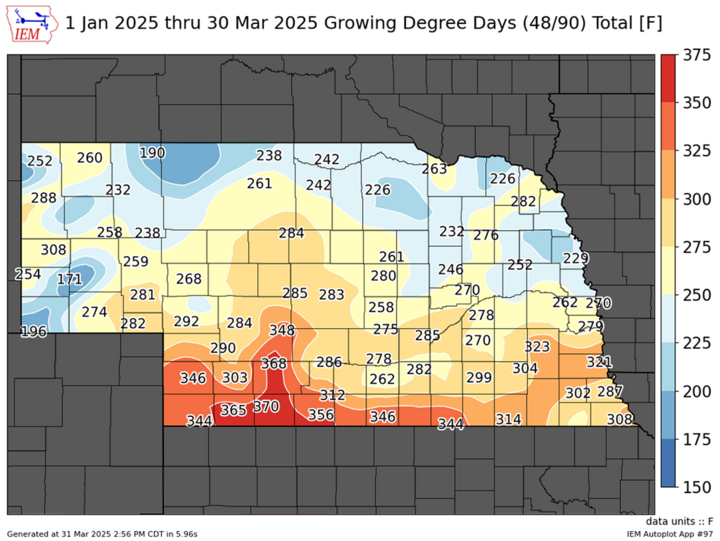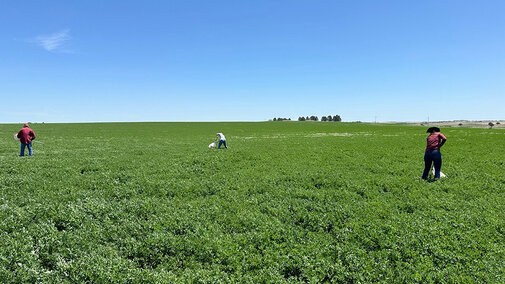Because insect development is largely controlled and affected by temperature, degree day (thermal unit) accumulations can be used to predict insect development and to inform when to initiate scouting. A general alfalfa weevil growing degree days model has been recommended by Kansas State University Extension (Table 1) with 48°F as the base developmental temperature starting on Jan. 1. Eggs are predicted to begin hatching after 300 growing degree days. However, it is possible that some eggs were laid from last fall or winter and had a head start for development. Therefore, alfalfa weevil scouting is recommended to start after 200 growing degree days have accumulated in Nebraska.
Degree days rapidly accumulated from several warm spells over the past weeks, and alfalfa weevil growing degree days have surpassed 200 across Nebraska. It is time to scout alfalfa fields for alfalfa weevil activities, especially counties in the southwestern part of the state where growing degree days have reached 300 (Figure 1).

Degree Days or Thermal Units | Stage | Importance |
25-300 | Eggs hatch | In stems |
301-450 | 1st and 2nd instars | Leaf pinholing - start sampling |
450-600 | 2nd and 3rd instars | Defoliation |
600-750 | 3rd and 4th instars | Defoliation |
750+ | Pupa to adult | Adults – some feeding - oversummering |
Scouting
Alfalfa weevil damage consists of small holes and interveinal feeding on the newest leaflets near the stem tips. The larvae are small (1/16- to 3/8-inch long) and pale yellowish-green, becoming a darker green when larger. These legless worms have black heads and a white stripe the length of the back (Figure 2). The alfalfa weevil larvae spend nearly all their time on the plant. They curl into a C-shape when disturbed.
Use a sweep net to detect the presence of weevils (Figure 2). If alfalfa weevil larvae are present, randomly select at least five sampling sites from across the entire field (walk the field in an “M” or “Z” pattern). At each site, gently pick or cut six alfalfa stems at ground level. Shake the larvae off the stems by beating the stems into a deep-sided bucket. Count the larvae and determine the average number of larvae per stem. Make sure to check for small larvae that may be enclosed in new, folded leaflets at the tips of the stems. Measure stem lengths and determine the average stem height.

Treatment
Economic thresholds can be used to make treatment decisions, which depend on plant growth stage, treatment cost and current hay value. If average larvae number per stem exceeds economic thresholds, management actions are recommended and will be profitable.
- For plant height less than 10 inches tall, refer to Table 2 for economic thresholds and use a long-residual product.
- For plant height taller than 10 inches, refer to Table 3 for economic thresholds and management recommendations.
If thresholds are reached within two weeks before cutting, early cutting may be more profitable than insecticide treatments.
Plant Growth Stage (Height) | Treatment Cost ($/acre) | Crop Value ($/ton) | ||||||||
$60 | $80 | $100 | $120 | $140 | $160 | $180 | $200 | $220 | ||
Early vegetative (0-12 inches) | $8 | 2.8 | 2.1 | 1.7 | 1.4 | 1.2 | 1.1 | 0.9 | 0.8 | 0.8 |
$12 | 4.2 | 3.2 | 2.5 | 2.1 | 1.8 | 1.6 | 1.4 | 1.3 | 1.2 | |
$16 | 5.6 | 4.2 | 3.4 | 2.8 | 2.4 | 2.1 | 1.9 | 1.7 | 1.5 | |
$20 | 7.0 | 5.3 | 4.2 | 3.5 | 3.0 | 2.6 | 2.3 | 2.1 | 1.9 | |
Plant Growth Stage (Height) | Treatment Cost ($/acre) | Crop Value ($/ton) | Management Decision | |||||
$50 | $75 | $100 | $125 | $150 | $175 | |||
Mid-vegetative (10-15 inches) | $7 | 3.6 | 2.2 | 1.5 | 1.1 | 0.9 | 0.7 | Use a long-residual product |
$8 | 4.1 | 2.6 | 1.8 | 1.4 | 1.1 | 0.8 | ||
$9 | 4.7 | 3.0 | 2.1 | 1.6 | 1.2 | 1.0 | ||
$10 | 5.3 | 3.4 | 2.4 | 1.8 | 1.4 | 1.2 | ||
$11 | 5.9 | 3.7 | 2.7 | 2.1 | 1.6 | 1.3 | ||
$12 | 6.4 | 4.1 | 3.0 | 2.3 | 1.8 | 1.5 | ||
Late vegetative (16-20 inches) | $7 | 3.8 | 2.4 | 1.8 | 1.4 | 1.1 | 0.9 | Use a short to mid-PHI/PGI* product |
$8 | 4.4 | 2.8 | 2.1 | 1.6 | 1.3 | 1.1 | ||
$9 | 4.9 | 3.2 | 2.4 | 1.8 | 1.5 | 1.2 | ||
$10 | 5.5 | 3.6 | 2.6 | 2.1 | 1.7 | 1.4 | ||
$11 | 6.1 | 4.0 | 2.9 | 2.3 | 1.0 | 1.6 | ||
$12 | 6.7 | 4.4 | 3.2 | 2.5 | 2.1 | 1.7 | ||
Early bud (>20 inches) | $7 | 4.0 | 2.7 | 2.0 | 1.6 | 1.3 | 1.2 | Cut early, or use a short PHI/PGI* product |
$8 | 4.6 | 3.1 | 2.3 | 1.8 | 1.5 | 1.3 | ||
$9 | 5.2 | 3.5 | 2.6 | 2.1 | 1.7 | 1.5 | ||
$10 | 5.8 | 3.8 | 2.8 | 2.3 | 1.9 | 1.6 | ||
$11 | 6.3 | 4.2 | 3.2 | 2.5 | 2.1 | 1.8 | ||
$12 | 6.9 | 4.6 | 3.5 | 2.8 | 2.3 | 2.0 | ||
50% bud or greater |
| Cut early | ||||||
*Pre-harvest interval/pre-grazing interval
Many insecticides are registered to control alfalfa weevil larvae. See the most recent edition of the Guide for Weed, Disease and Insect Management in Nebraska (EC130) for rates and restrictions of commonly used insecticides for alfalfa weevil larval control. They differ in their modes of action and pre-harvest intervals.
Previously, pyrethroids (active ingredient ends in "thrin") have been highly effective for alfalfa weevil control. However, alfalfa weevils have developed resistance to multiple pyrethroid insecticides across the western United States (including Arizona, California, Montana, Oregon, Washington and Wyoming). Resistance has not been confirmed in Nebraska, but some producers have reported poor control with pyrethroid products, including lambda-cyhalothrin (Paradigm, Silencer, Warrior II) and beta-cyfluthrin (Baythroid XL), in recent year.
The Crops IPM Entomology Lab at the Panhandle Research, Extension and Education Center will initiate a screening program for pyrethroid resistance in alfalfa weevil this spring. If you experienced severe alfalfa weevil outbreaks and pyrethroid control failure in the past three years, please contact Dr. Pin-Chu Lai (308-632-1369) or co-authors for more information on how to enter for alfalfa weevil resistance testing.
Alternatively, indoxacarb (Steward) and chlorpyrifos are effective insecticides against alfalfa weevil. Note that existing stocks of products containing chlorpyrifos that are currently labeled for alfalfa in Nebraska can only be used until June 30, 2025. Please check out this article for more information.
Resources
- Alfalfa Weevil, by Jeff Whitworth, Holly Davis, and Amie Norton. Kansas State University Agricultural Experiment Station and Cooperative Extension Service. MF2999
- It’s Time to Scout for Alfalfa Weevils, by Adam Varenhorst. South Dakota State University Extension.
- Integrated Pest Management of Alfalfa Weevil in North Dakota (E1676), by Patrick B. Beauzay, Janet J. Knodel, G.A.S.M. Ganehiarachchi, 2013. NSDU Extension Service, Fargo, ND.
- Alfalfa Weevil, by Ashley Dean and Erin Hodgson. Iowa State University Extension and Outreach, Ames, IA.
- Alfalfa weevils (Coleoptera: Curculionidae) in the western United States are resistant to multiple type II pyrethroid insecticides, by Erika A Rodbell, Christopher G Caron, Silvia I Rondon, M Umer Masood, Kevin W Wanner, 2024. Journal of Economic Entomology 117(1): 280-292.

